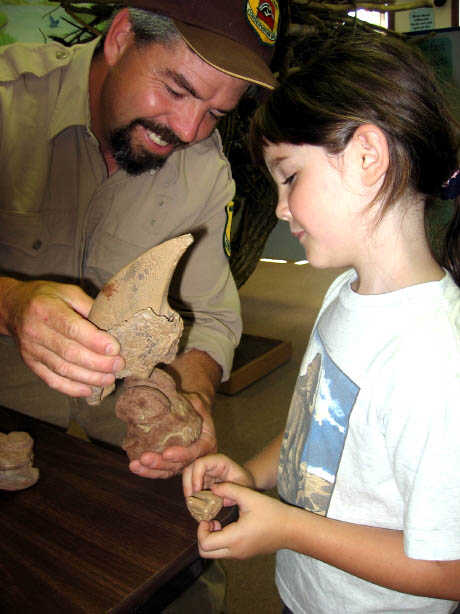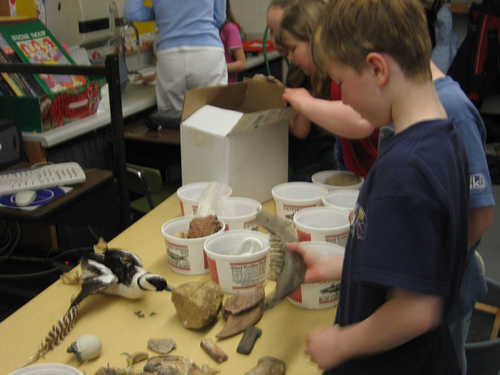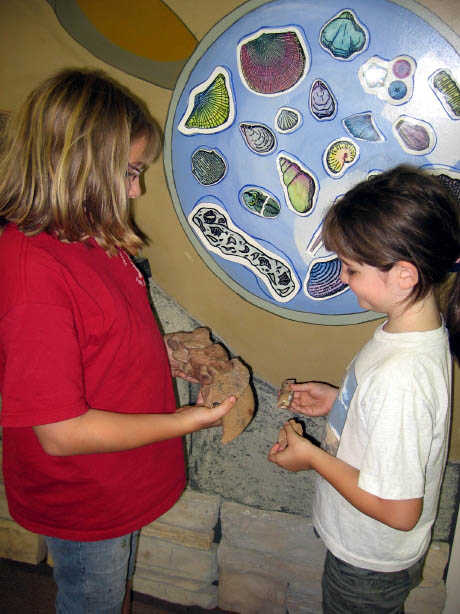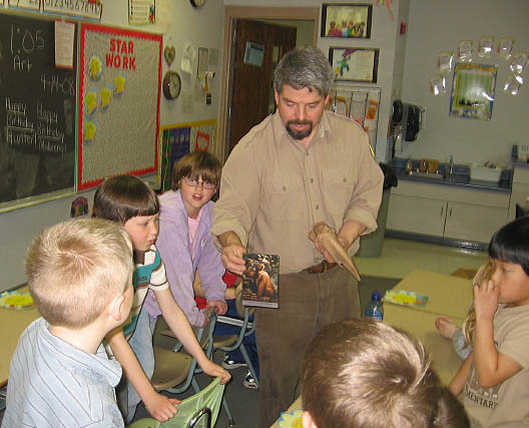Cleared the entire area (approx 10m X 2m) yesterday, a half-day sooned than expected. Unfortunately we weren’t slowed by finding any sloth bones. Recovered a single turtle bone. It’s a nice find though–our second species of turtle. Should aid in further defining the mysterious watery environment that left this 4 ft.-thick layer of remarkably homogenous clay. Ron’s ultra-sound tests gave him some promising data; he collected clay samples to take back to the university for further tests. With both the north and south borders of the creek cleared it looks now like we have just a couple of large areas in the middle of the creek left to excavate. We’ve probed for bones there and have confirmed their presence. We’re thinking about doing some prep work with an excavator in the next couple of weeks, before the ground freezes solid, and returning before the spring floods to finish digging. Photos next week. . . . Dave
Author Archives: David
Digging this weekend!
After two years of delays due to high water and a couple false starts we’re back at the site this weekend with a full crew of volunteers–many veterans from previous digs. Here’s a link to a story published this week in the local paper.
http://www.zwire.com/site/news.cfm?newsid=20212313&BRD=2703&PAG=461&dept_id=555139&rfi=6
Lynn Alex is back again with 4 other staff-members from the UI Office of the State Archaeologist (OSA). Ron Vogel is back too representing the UI Department of Physics and Astronomy. He brought equipment to test the feasibility of using ground-penetrating ultra-sound to locate bones. Herb Dircks is here with his grandson Cyril. Herb is a rapid protoyping consultant in the UI Engineering Design and Prototyping Center where he has been making duplicates of sloth bones to aid our research, using computed tomography (CT) scans supplied by the the Department of Radiology and Biomedical Engineering. Dr. Rob McAfee http://www.sloth-world.org/ is driving in again from Doane College, Crete, NE; and Don Johnson is also returning representing the Eastern Iowa Paleontology Project. Andy Clack flew in from McMaster University, Hamilton, Ontario, where he is studying ancient DNA under Hendrik Poinar in the Ancient DNA Centre.
There’s no way to thank everyone here for volunteering their time, in near freezing weather, to move the project forward. More tomorrow. . . . Dave
Voices in the forest: echos of the ice age
The Pleistocene mass-extinction left a number of  plants and animals ill-adapted to modern life—trees with fruit or seeds too large to be swallowed and transported (Janzen and Martin, 1982), with outmoded defenses (Barlow, 2000), or waiting endlessly for agents of disturbance that are no more. They are the survivors of vanished communities, still reflecting the forces under which they evolved for hundreds of thousands of years, and often in decline today. They are the ghosts and orphans of the Ice Age. I have seen an ice age ghost, and it’s a nightmare! (image borrowed from)
plants and animals ill-adapted to modern life—trees with fruit or seeds too large to be swallowed and transported (Janzen and Martin, 1982), with outmoded defenses (Barlow, 2000), or waiting endlessly for agents of disturbance that are no more. They are the survivors of vanished communities, still reflecting the forces under which they evolved for hundreds of thousands of years, and often in decline today. They are the ghosts and orphans of the Ice Age. I have seen an ice age ghost, and it’s a nightmare! (image borrowed from)
Seeds for thought
 We’ve received our preliminary reports on the fossil seeds and pollen from . The seeds are what you would expect to find in the backwater-areas of a river—wetland taxa and weedy types profiting from the local disturbances. The pollen report is intriguing though– oak, pine, cedar and hickory, with some more weeds and lowlanders tossed in. A couple of things stand out—of course there are many different kinds of oaks and pines, etc., each with its own requirements, but generally they all need large doses of direct sunshine to grow. Their seedlings don’t survive in the shade. We found the tip of one spruce needle, but this doesn’t add up to being a dense boreal spruce forest. With oaks and hickories, etc., it feels a lot like the Iowa we know—different species possibly, but in form and type of trees, the landscape we inherited from the Native Americans 150 years ago. Photo borrowed from)
We’ve received our preliminary reports on the fossil seeds and pollen from . The seeds are what you would expect to find in the backwater-areas of a river—wetland taxa and weedy types profiting from the local disturbances. The pollen report is intriguing though– oak, pine, cedar and hickory, with some more weeds and lowlanders tossed in. A couple of things stand out—of course there are many different kinds of oaks and pines, etc., each with its own requirements, but generally they all need large doses of direct sunshine to grow. Their seedlings don’t survive in the shade. We found the tip of one spruce needle, but this doesn’t add up to being a dense boreal spruce forest. With oaks and hickories, etc., it feels a lot like the Iowa we know—different species possibly, but in form and type of trees, the landscape we inherited from the Native Americans 150 years ago. Photo borrowed from)
Ice Age shadows and a vision for the future
 Cedar Rapids has released its plan for restoring the neighborhoods ravaged by this summer’s floods. I’m disappointed. I was hoping for a bolder vision, something that recognized the increased likelihood of future floods and turned the riverfront in a more sustainable direction—like an Ice Age Zoological Park recreating the sloths’ habitat. Besides serving as an important tool for education and research about Iowa’s truly natural environment (i.e. before Native American alterations to the land) and a valuable wildlife corridor, a natural environment park would bring significant commercial development opportunities, tourist revenue and jobs. A riverfront park could be designed to meet the Cedar River half way and work with its perennial floods instead of against them, like the truce Davenport, IA has forged with the Mississippi. Restored wetlands, lakes and other containment basins could absorb water rather than speeding its way onward to create bigger problems for the communities downstream. Large urban zoological parks aren’t without precedent. The 1,800-acre San Diego Zoo Wild Animal Park is one of the largest tourist attractions in southern California with attendance of 2 million visitors annually (Wikipedia, 2008). Why not here? (image One Way Street by bpkelsey, borrowed from)
Cedar Rapids has released its plan for restoring the neighborhoods ravaged by this summer’s floods. I’m disappointed. I was hoping for a bolder vision, something that recognized the increased likelihood of future floods and turned the riverfront in a more sustainable direction—like an Ice Age Zoological Park recreating the sloths’ habitat. Besides serving as an important tool for education and research about Iowa’s truly natural environment (i.e. before Native American alterations to the land) and a valuable wildlife corridor, a natural environment park would bring significant commercial development opportunities, tourist revenue and jobs. A riverfront park could be designed to meet the Cedar River half way and work with its perennial floods instead of against them, like the truce Davenport, IA has forged with the Mississippi. Restored wetlands, lakes and other containment basins could absorb water rather than speeding its way onward to create bigger problems for the communities downstream. Large urban zoological parks aren’t without precedent. The 1,800-acre San Diego Zoo Wild Animal Park is one of the largest tourist attractions in southern California with attendance of 2 million visitors annually (Wikipedia, 2008). Why not here? (image One Way Street by bpkelsey, borrowed from)
The little matter of elephant garlic
 McDonald (1977) was the first to note the similarity of Megalonyx teeth to those of VAMPIRE BATS. Like sloths, but unlike other bats and most other mammals, the common vampire bat, Desmodus rotundus, has teeth that are comprised entirely of dentin, with a jacket of cementum. SEM analysis shows the thin layer of enamel that vampire bats have at birth wears away quickly (Freeman, 1998). As in Megalonyx, the bats’ teeth are ever-growing.
McDonald (1977) was the first to note the similarity of Megalonyx teeth to those of VAMPIRE BATS. Like sloths, but unlike other bats and most other mammals, the common vampire bat, Desmodus rotundus, has teeth that are comprised entirely of dentin, with a jacket of cementum. SEM analysis shows the thin layer of enamel that vampire bats have at birth wears away quickly (Freeman, 1998). As in Megalonyx, the bats’ teeth are ever-growing.  They compensate for the rapid wear of the soft material by grinding upper teeth against lower in a systematic way to keep them sharp (Phillips and Steinberg, 1976). Ever-growing teeth are common in rodents but the biting surface in this case is a combination of dentin and enamel. As the softer dentin erodes and the enamel precipice chips, the animals are left with a long-lasting but jagged edge. A nice tool for cutting and slicing plants and seeds, but vampire bats depend on stealth to secure their meals. A smooth razor blade works better than a serrated edge for shaving hair or feathers off a patch of skin and making a clean painless incision. The cementum jacket of the bats’ teeth is about as hard as the dentin, eliminating the chipping problem where they meet. But the ugly rumors about sloths and vampire bats didn’t get started simply because of tooth morphology. The scandal-mongers cite several other lines of evidence for making this unsavory connection.
They compensate for the rapid wear of the soft material by grinding upper teeth against lower in a systematic way to keep them sharp (Phillips and Steinberg, 1976). Ever-growing teeth are common in rodents but the biting surface in this case is a combination of dentin and enamel. As the softer dentin erodes and the enamel precipice chips, the animals are left with a long-lasting but jagged edge. A nice tool for cutting and slicing plants and seeds, but vampire bats depend on stealth to secure their meals. A smooth razor blade works better than a serrated edge for shaving hair or feathers off a patch of skin and making a clean painless incision. The cementum jacket of the bats’ teeth is about as hard as the dentin, eliminating the chipping problem where they meet. But the ugly rumors about sloths and vampire bats didn’t get started simply because of tooth morphology. The scandal-mongers cite several other lines of evidence for making this unsavory connection.
If you are what you eat
 It doesn’t sparkle like the Hope diamond or King Tut’s gold, but the most amazing artifact in the museum is an oblong softball-sized coprolite from a ground sloth. It came to us from a donor who in the early 1970’s helped her father, a National Park Service ranger, collect samples from a cave near the west end of the Grand Canyon. Kids being kids, a couple of the giant horse apples were ”forgotten” on the bottom of a knapsack—puny wages for a day of packing sloth poop down to an NPS boat 500 feet below, on a path scuffed out by very different feet 30,000 years earlier. The donor lives in Iowa now and read about the sloth project. . . the rest you know.
It doesn’t sparkle like the Hope diamond or King Tut’s gold, but the most amazing artifact in the museum is an oblong softball-sized coprolite from a ground sloth. It came to us from a donor who in the early 1970’s helped her father, a National Park Service ranger, collect samples from a cave near the west end of the Grand Canyon. Kids being kids, a couple of the giant horse apples were ”forgotten” on the bottom of a knapsack—puny wages for a day of packing sloth poop down to an NPS boat 500 feet below, on a path scuffed out by very different feet 30,000 years earlier. The donor lives in Iowa now and read about the sloth project. . . the rest you know.
Sloth anatomy challenge
 Species evolve in the most astonishing ways! That idea was reinforced for me recently when I was rereading Greg McDonald’s thesis and stumbled across a note about Megalonyx teeth that I hadn’t caught previously. I’ve written before about sloth teeth and the error of assuming differences between sloths and other mammals are evidence they were inept or stupid and maladapted. Some remarkable mammals owe much of their success to abandoning the “normal” patterns of the so-called “higher” mammals and following the path of ground sloths. Greg cites an amazing example . . . as my generation would say, the implications are mind-blowing! (image borrowed from)
Species evolve in the most astonishing ways! That idea was reinforced for me recently when I was rereading Greg McDonald’s thesis and stumbled across a note about Megalonyx teeth that I hadn’t caught previously. I’ve written before about sloth teeth and the error of assuming differences between sloths and other mammals are evidence they were inept or stupid and maladapted. Some remarkable mammals owe much of their success to abandoning the “normal” patterns of the so-called “higher” mammals and following the path of ground sloths. Greg cites an amazing example . . . as my generation would say, the implications are mind-blowing! (image borrowed from)
So here’s the challenge: There’s a living mammal with teeth that bear a remarkable functional resemblance to those of Megalonyx (excluding other Xenarthrans). That is, its teeth are made up entirely of dentin wrapped in a layer of cementum, and as in sloths they are self-sharpening and ever-growing. What animal is it and what special advantage does this adaptation give it to survive in its unique niche?
No fair running out and getting Greg’s thesis. Think about it and send in your guesses–remember to include your rationale. . . you are in for a surprise. The answer in two weeks. . . . Dave
Getting ready: new photos from the site
 Holmes and I drove out to Shenandoah last week, and with Phil Mather’s help (Mather & Sons Construction) repaired the berm and opened up a new search area under the slump block on the south side of the creek.
Holmes and I drove out to Shenandoah last week, and with Phil Mather’s help (Mather & Sons Construction) repaired the berm and opened up a new search area under the slump block on the south side of the creek.
 There’s a stubborn but hard-working beaver just downstream from the site that isn’t taking the hint that it needs to move out. Bob tore the dam out twice last week before we arrived. The third time is a charm.
There’s a stubborn but hard-working beaver just downstream from the site that isn’t taking the hint that it needs to move out. Bob tore the dam out twice last week before we arrived. The third time is a charm.
There’s rain in the forecast this week, but as soon as we can get in there again we plan to pump out the water and clear the muck from the floor with a crawler. Volunteers: With any luck we will put out a Sloth Dig Alert in the next three weeks. Keep your eyes peeled. Dave
No left turn
 One of the many mysteries we have about the sloth site is why we have so many more bones from the right side than left side of the adult. (The photo (below) is misleading—it comes from an outreach program where we had to spread the bones out so that viewers on the “bad” side had something to look at. The real difference isn’t absolute, but it’s striking.) There’s no intrinsic reason why the bones on one side of the sloth should have fossilized better than the other, so it must indicate something about the conditions near the time of death. (photo borrowed from)
One of the many mysteries we have about the sloth site is why we have so many more bones from the right side than left side of the adult. (The photo (below) is misleading—it comes from an outreach program where we had to spread the bones out so that viewers on the “bad” side had something to look at. The real difference isn’t absolute, but it’s striking.) There’s no intrinsic reason why the bones on one side of the sloth should have fossilized better than the other, so it must indicate something about the conditions near the time of death. (photo borrowed from)
Sloth program photos, Mahaska County
 These photos came in recently from Pete Eyheralde, the Naturalist at the Mahaska County (IA) Conservation Board. He presented a couple of fossil programs this year which highlighted the sloths. Pictured: First graders at Moravia Elementary School.
These photos came in recently from Pete Eyheralde, the Naturalist at the Mahaska County (IA) Conservation Board. He presented a couple of fossil programs this year which highlighted the sloths. Pictured: First graders at Moravia Elementary School. 
Pete is a long-time member of our Sloth Rapid Response Team, a veteran of several digs and has also assisted with fossil prep. in the lab here. (The sloth fossils in the photos are cast replicas we made here at the University just for this purpose.)
 This photo is from his Nature Center and a day this summer when a group of children came out to go fossil hunting in the old limestone quarry they have there at the Russell Wildlife Area.
This photo is from his Nature Center and a day this summer when a group of children came out to go fossil hunting in the old limestone quarry they have there at the Russell Wildlife Area.
Visit his web site at http://www.mahaskaconservation.com/naturecenter/index.php. Thanks Pete.
New photos from the site
We drove out to see the site Tuesday. The water level in the creek has dropped considerably in recent weeks owing to record-low rainfall in August. Bob thought we could start getting ready to dig again, but advised us to see the drastic changes in the topography since the floods earlier this year.
Phil Mather (left), Mather & Sons, who has come to our rescue a dozen times in the last 5 years with his excavating equipment and long experience; Holmes (center); Bob Athen (right), the landowner and discoverer of the sloth. 
Looking downstream over the site. The floods straightened out all the curves in the creek .
Another view downstream and slightly north overlooking the dig site.
Looking upstream toward the north bank. The flood erased all traces of the road Mather built to access the site and the large hole we dug to reach the bones. Good thing we were finished over there any way.
We came up with a plan and hoped to resume digging in just a couple of weeks but a thunderstorm hit as we were leaving Wednesday morning and dropped 1.44 inches on Shenandoah–as much as 4 inches upstream. No telling how high the water rose. . . we may be stalled for a few more weeks. . . . Dave




